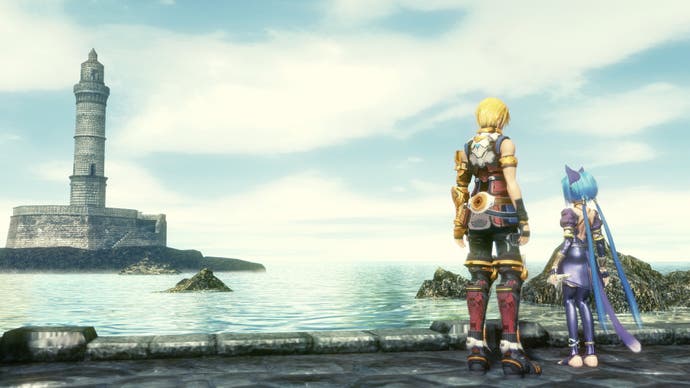Star Ocean: The Last Hope
Adrift.
Holding down the B button at any point will ready your character for a 'blindside' manoeuvre, which, combined with a tap of the directional button at the moment of an enemy attack, enters a slow-motion mode as your character nips behind the enemy to land a critical blow. Combined with selectable chain combos on the trigger buttons, as well as a range of different skills that can be called up and executed via an in-battle menu, you have a pleasing amount of freedom during combat, which equally tests strategy, precision and timing.
A bonus board, consisting of 14 tiles, sits on the right-hand side of the screen, This fills up with tiles of different colour when you meet certain conditions during battle (e.g. finishing an enemy with a critical blow) and offer modifiers on your experience or money earned during fights. The board clears of tiles when you take a critical hit, so, as well as all of the other considerations in battle, you must attempt to make your bonus board as well-connected as possible while avoiding hard hits from enemies.
Character-customisation throughout the game is another strength. Skill points can be spent purchasing and upgrading a huge variety of active and passive skills on a per-character basis. Opening treasure chests and completing side-quests earns skill points which can either be spent on levelling up these abilities or in the game's inaccessible but ultimately rewarding item-crafting mini-game. As such every action feeds cohesively into building a personalised team. 15 hours in, the range of attacks and possible chains is vast and, far more so than in many RPGs, each character in your squad feels like the sum total of your decisions.
Characters earn trophies for performing certain feats in battle, landing 10 consecutive hits unassisted, dealing exactly 55 points of damage and so on. Each character has 100 of these trophies to collect, which contribute to real Xbox Achievements for collecting the set. This sense of achievements within achievements characterises the detail of the game, which is awash with collectable items and quests. You're encouraged to collect monster data on all 154 enemies in the game, find the schematics of every spaceship in the universe (by hacking into computer consoles wherever you find them), and craft and investigate all 147 weapons in the game. The result is a gigantic raft of concurrent micro-missions that the conscientious player must juggle in their mind if they're to fully complete the game and earn all of its hard-won Achievements.

But there's a sense that in spending so much time on the detail, Square Enix may have lost sight of the bigger picture. At least half of the game's quests are optional, as are all of the collectables, crafting recipes and customisable skills for characters. Sidestep these attractions and you're left with a gargantuan shell of a game, one whose story is too drawn out to gain momentum and whose characters are little more than personal mannequins to be clothed with your chosen items and abilities.
The best science-fiction pays equal attention to the direction of its fiction as to its detail but Star Ocean: The Last Hope succeeds only in the latter area, and even there, only in part. There are good lessons to be drawn: the battle system is magnificent and the experience as a whole offers a compelling journey for the collect 'em up completist. But if this truly represents Square Enix's last hope for the science-fiction RPG, then it's highly unlikely it can endure as well as their final fantasy for the Tolkein epic. Like NASA's astronauts, we may simply be destined to spend our future not being in space.

